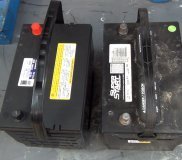The charging system is working perfectly. The question is why the ammeter is reading so low. 14.34 volts at the battery is perfect. It's normal for one small wire on the alternator to read a tenth of a volt lower due to the losses in the wires and automatic shutdown relay contacts. 10.22 volts on the control wire is also just fine. The lower that voltage is, the harder the alternator is working. The difference of 4.00 volts is what is creating the electromagnet that's needed to generate output current.
For intermittent slow cranking, you may want to measure the voltage right at the starter on the fatter battery cable while a helper cranks the engine. The industry standard is it should go no lower than 9.6 volts. If it does you either have bad bushings in the starter and the armature is dragging or there's a bad connection or numerous frayed strands of wire on the cable, sometimes hidden under the insulation.
If you find the voltage at the starter is okay, or even a little higher than normal, say around 11.0 volts, there may be one open pair of brushes in the starter motor. That will cause it to draw half the normal current at first. Without going into lots of electrical theory, current flow will be correct and normal, but the strength of the motor will be half of normal. Typically the worn brush will make contact once the armature starts to spin, then the cranking speed will be back to normal, but as that brush continues to wear, the slow cranking will appear more frequently.
Thursday, June 20th, 2013 AT 1:33 AM




